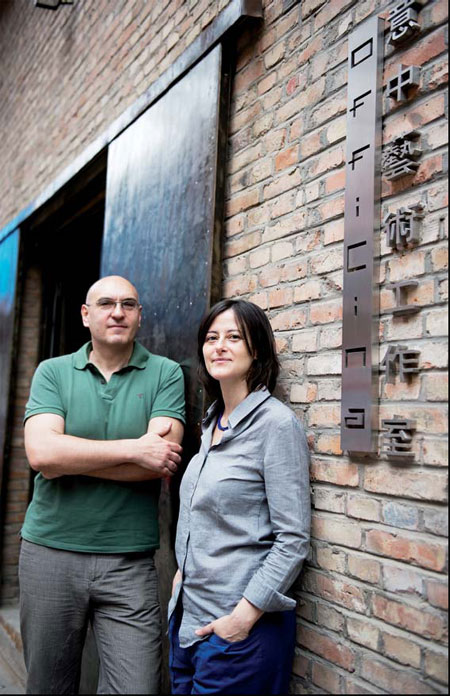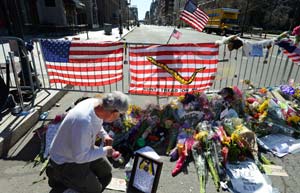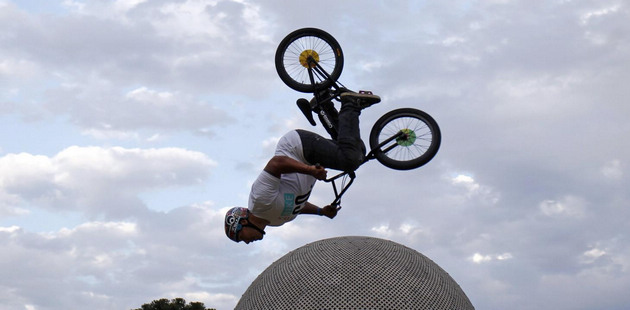Arts put Italian pair in the zone
Updated: 2012-10-12 09:59
By Lin Jing and Su Zhou (China Daily)
|
||||||||
|
Rosario Scarpato and Monica Piccioni enjoy life in 798 Art Zone. Provided to China Daily |
Years of working in China add up to a mountain of expertise now being harvested in the cultural field
Few people appreciate more than Rosario Scarpato and Monica Piccioni that like Rome, 798 Art Zone was not built in a day.
The two Italians have been closely connected to the now celebrated Beijing venue since 2002, a year after it began to attract serious and widespread attention as a center for the arts.
Their considerable contribution to 798 has come largely through offiCina Ltd, a gallery and curatorial practice that specializes in the visual arts, which the pair set up in Beijing in 2002. Since then it has promoted contemporary art projects such as art exhibits, cultural events, seminars, workshops, film and video screenings.
Scarpato offers a clear idea of offiCina's mission and philosophy by explaining the company's name.
The Italian word officina means workshop or atelier, Scarpato says, "but also alludes, in a figurative way, to a place where art and culture are freely fostered".
Cina is Italian for China, so from the time offiCina was set up, "our creativity was focusing on China", he says.
Scarpato and Piccioni have extensive experience with cultural exchange programs between Italy and China, and this played no small role in the gallery's birth.
Related reading: The art factory
As soon as China entered the World Trade Organization in 2001, they grabbed the chance to establish an art-project agency to build up a dialogue between China and Italy in the visual arts.
"The abandoned Bauhaus-style 798 factory with low rent thrilled us profoundly," Scarpato says. In October 2002, attending the inaugural event of Beijing Tokyo Art Projects, the first foreign gallery in 798, they met many artists and were captivated by the atmosphere.
During the 1980s and 1990s they had worked with foreign public and private companies to provide assistance in doing business and maintaining liaisons with cultural institutions.
Before offiCina was founded, Piccioni worked for several years at the Italian embassy in Beijing and later collaborated with the Chinese Ministry of Culture and the Italian Trade Commission.
She has also given lectures and public presentations on Chinese contemporary art and Italian literature organized by academic institutions such as Milan University and Beijing Foreign Studies University.
Scarpato has worked as a consultant throughout China, helping foreign entrepreneurs to develop their businesses and public institutions to establish commercial and cultural exchanges.
Those years of managing commercial projects and traveling with business missions in China helped them develop expertise in managing exhibitions and events, and provided personal contacts for future development, Scarpato says.
Now he works as general manager and creative director for the gallery and Piccioni is the curator.
From 2004 to 2011 offiCina organized more than 50 projects in collaboration with artists, critics, media, museums, art academies and governmental bodies.
The more than 20 years that each of them has spent in China has given them the perfect chance to witness the evolution of China's arts environment.
Since the 1970s and the 1980s Chinese artists have absorbed a lot from Western art and ideas through books, magazines and what for many was their first contact with foreigners. Some exhibitions and activities were clandestine, Scarpato says.
But now Chinese artists can consider themselves to be in a global arena, and are always eager to stay abreast of artistic developments far and wide, he says. "A more intimate consciousness of himself/herself brings the artist to feel and think more international, even remaining completely Chinese."
Unlike other galleries or studios in 798, offiCina regards itself as an art cave where artists, students, media, collectors, amateurs and friends can meet and exchange views, ideas, projects and dreams.
"Our main business scope is not to sell artworks," Scarpato says. "We work on a project-by-project basis. Most of our initiatives are focused on experimental contemporary art, such as photography, moving images, installation and performance."
The company has staff in Italy and China, including assistants, Web and graphic designers, architects and sound experts.
It selects Chinese artists to take part in its exhibitions and other art projects, and organizes workshops and lectures with the help of museums, galleries and local media.
This autumn the company will start a new cooperation with two experimental art spaces in Rome, Hyunnart and La Nube di Oort, aiming to establish "a transcultural and interdisciplinary hub".
Scarpato says that during the past 10 years most of its projects have covered all of their costs, but looking for sponsors and funds, public or private, in China or abroad, has been daunting. "It was a kind of daily challenge. We introduced artists with a high cultural profile and had to do a lot of fundraising activity to sponsor our projects considering that many of these artists were still unknown in China."
Apart from the financial crisis and the European sovereign debt crisis, the constant rise in running costs has not helped.
"If the market experiences a profound crisis for years, our foreign financing partners stop investing in the arts," Scarpato says.
The agency is now reconsidering its market position. "We are investing energies and efforts plus personal contacts between Italy and China into more interconnected areas of art and culture, such as Beijing or Shanghai, Chengdu or Guangzhou, Xi'an or Nanjing, Chongqing or Hohhot. We hope to raise more interest from entrepreneurs."
Scarpato says that they will select potential investors and try to meet and convince them of the cultural impact on the audience, by theme of the project.
Nowadays many foreign art institutions are setting up shop in China. Gu Zhenqing, an independent exhibition planner, says that trend has been particularly marked since China joined the WTO.
"Art exchanges always come with economic exchanges, given that art is the best way to know a countries' people."
Cheng Guoqin, curator of XYZ Gallery Beijing in 798, says that there will be more opportunities than risks with foreign galleries coming. "798 cannot be called an international art zone if there are no international art institutions. Western galleries can help to bring overseas collectors and critics to 798 and enhance the management level and quality of artworks indirectly."
Scarpato says this trend will benefit Chinese art. "More foreign institutions need to enter this market so that a truly contemporary art sector is established in the short to middle term.
"With exchanges of ideas, collaboration between diverse actors, presentation of artists and their artworks, the way of operating differently will bring fresh blood to the local art system."
Scarpato says that Chinese artists should try to create artworks without reference to foreign cultures.
"What we like about Chinese art is the possibility for the artists to look at their ancient history and culture to visualize a new promising future, also contributing to a diverse perspective to look at life and at the meaning we often imagine for it."
Contact the writers at linjingcd@chinadaily.com.cn and suzhou@chinadaily.com.cn
(China Daily 10/12/2012 page15)
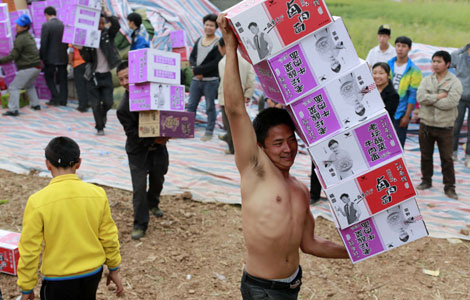
 Relief reaches isolated village
Relief reaches isolated village
 Rainfall poses new threats to quake-hit region
Rainfall poses new threats to quake-hit region
 Funerals begin for Boston bombing victims
Funerals begin for Boston bombing victims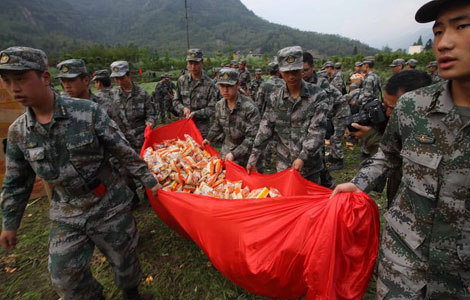
 Quake takeaway from China's Air Force
Quake takeaway from China's Air Force
 Obama celebrates young inventors at science fair
Obama celebrates young inventors at science fair
 Earth Day marked around the world
Earth Day marked around the world
 Volunteer team helping students find sense of normalcy
Volunteer team helping students find sense of normalcy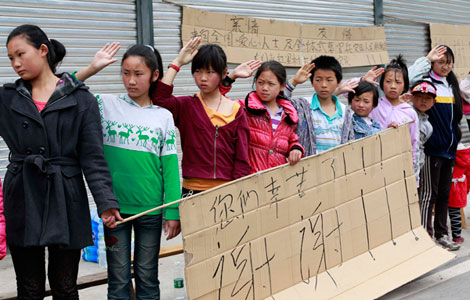
 Ethnic groups quick to join rescue efforts
Ethnic groups quick to join rescue efforts
Most Viewed
Editor's Picks

|

|

|

|

|

|
Today's Top News
Chinese fleet drives out Japan's boats from Diaoyu
Health new priority for quake zone
Inspired by Guan, more Chinese pick up golf
Russia criticizes US reports on human rights
China, ROK criticize visits to shrine
Sino-US shared interests emphasized
China 'aims to share its dream with world'
Chinese president appoints 5 new ambassadors
US Weekly

|

|
